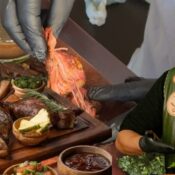
The Tunisian Plate or Shan Tounsi : A Dish Conceived by Jews and Developed by Tunisians
The Jewish minorities who passed through Tunisia left a clear mark on Tunisian cultrue and heritage, extending to Tunisian cuisine.
The Tunisian plate was among a group of foods that became famous with the Jews of Tunisia, who practiced the trade of "kaskrout" or "sandwich," displaying and selling these foods to passersby in the street. Among the most famous Jews who excelled in preparing this meal was "Malino," who owned a shop in the center of the capital Tunis in the 1970s. He relied on fresh and hot Italian bread in its
preparation.
Some Jews still offer this dish and other popular foods to their customers, including Loulouche Jacob, who runs a popular restaurant in the suburb of Halq al-Wad. What distinguishes Jewish cuisine is its ease of preparation and its low cost, as it relies on vegetables. It is also sold in restaurants at cheap prices.
Over time, the Tunisian dish began to evolve and gain popularity, becoming the distinctive light meal of Tunisia and one of its most popular dishes. It is preferred by Tunisians from all social classes due to its harmoniously composed ingredients of vegetables, eggs, olive oil, and pickles, in addition to its affordable price.
Tunisians have become creative with this dish by including ingredients ranging from traditional and famous salads (green salad, grilled salad, and Omek Houria), with the addition of a boiled egg, tuna, olive oil, olives, lemon, pepper, and , of course, Harissa. Thus, beautiful and vibrant colors are formed inside the dish, making the mouths of passersby water as they line up in front of the shops to get it.


